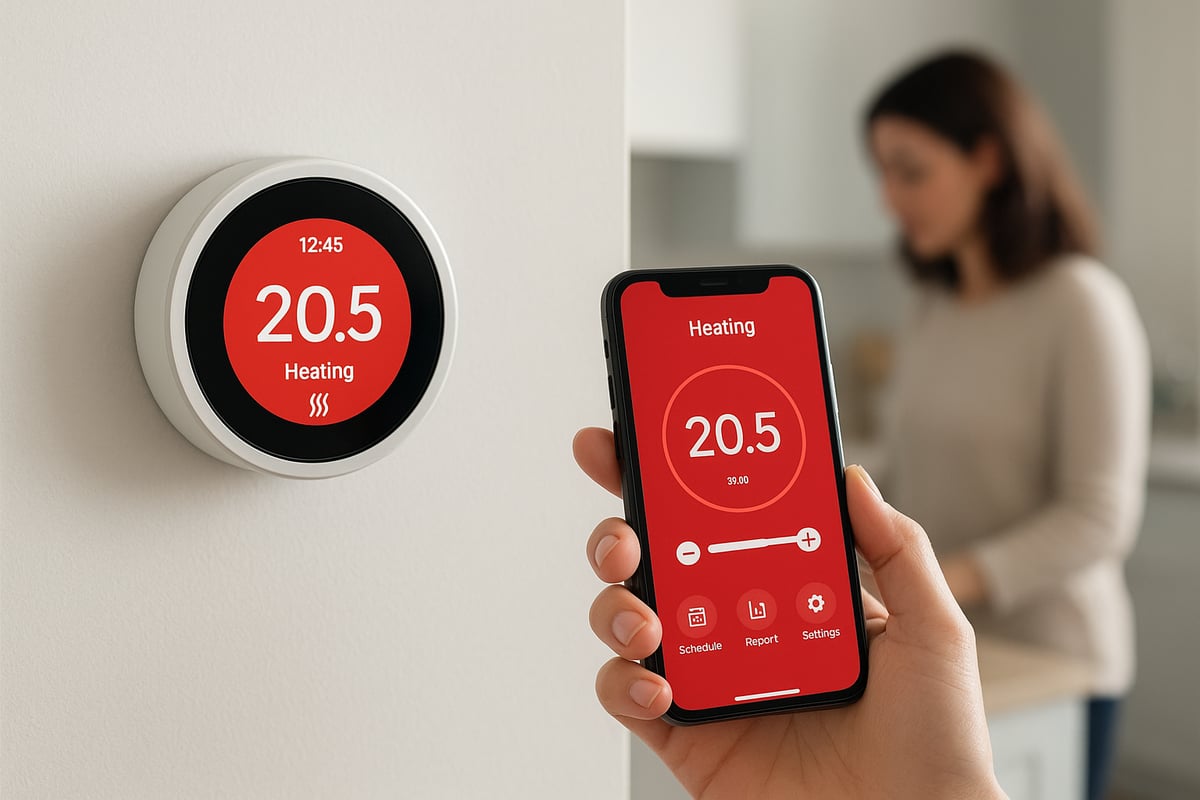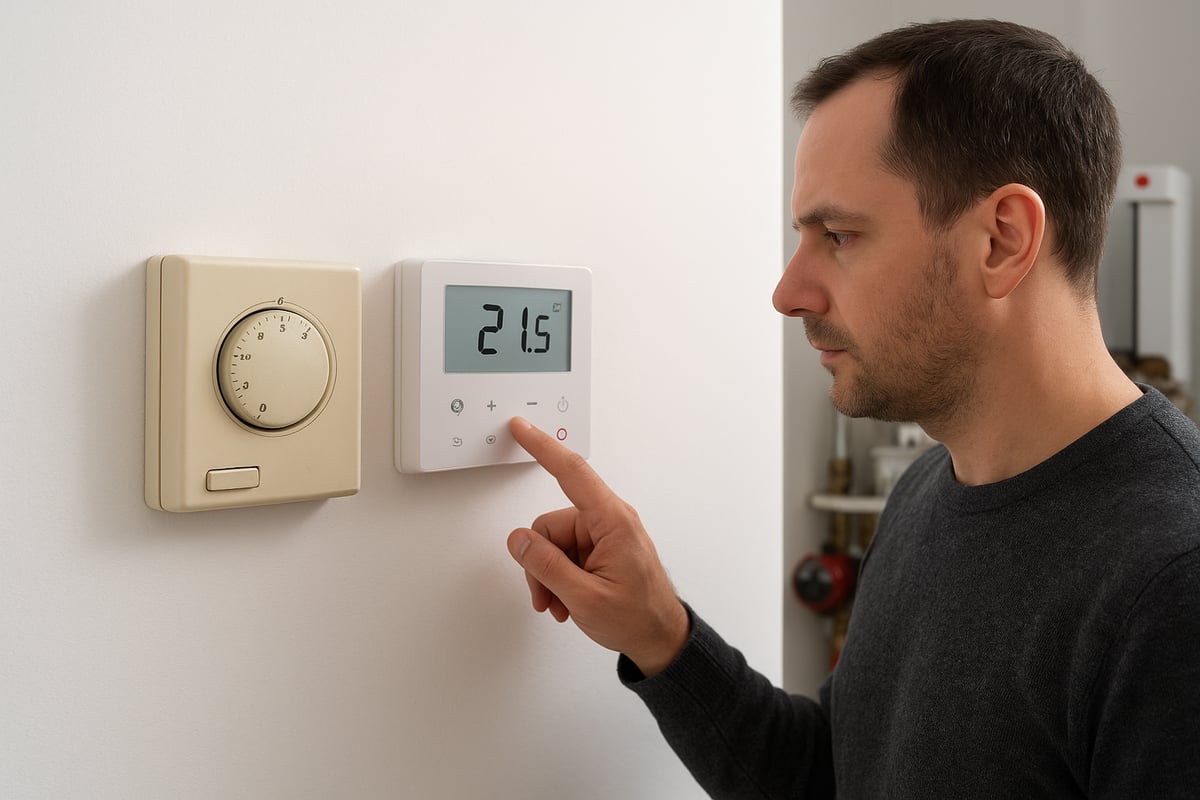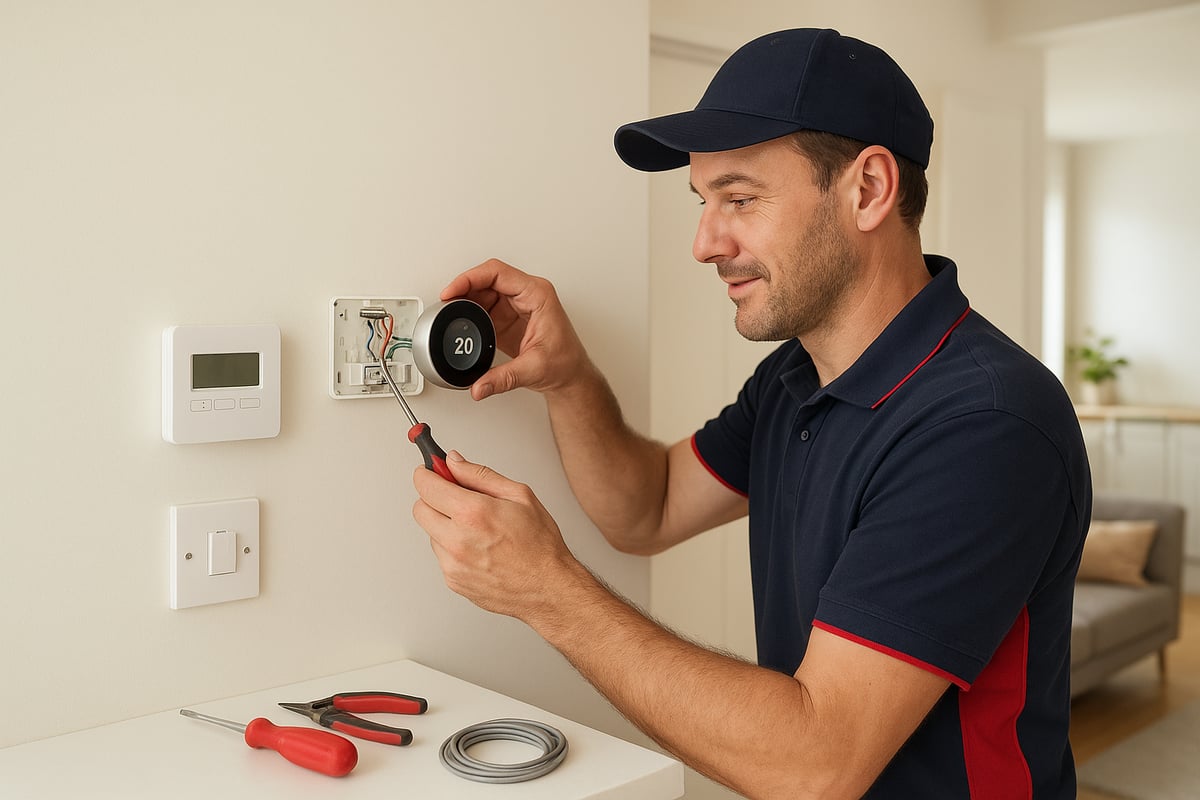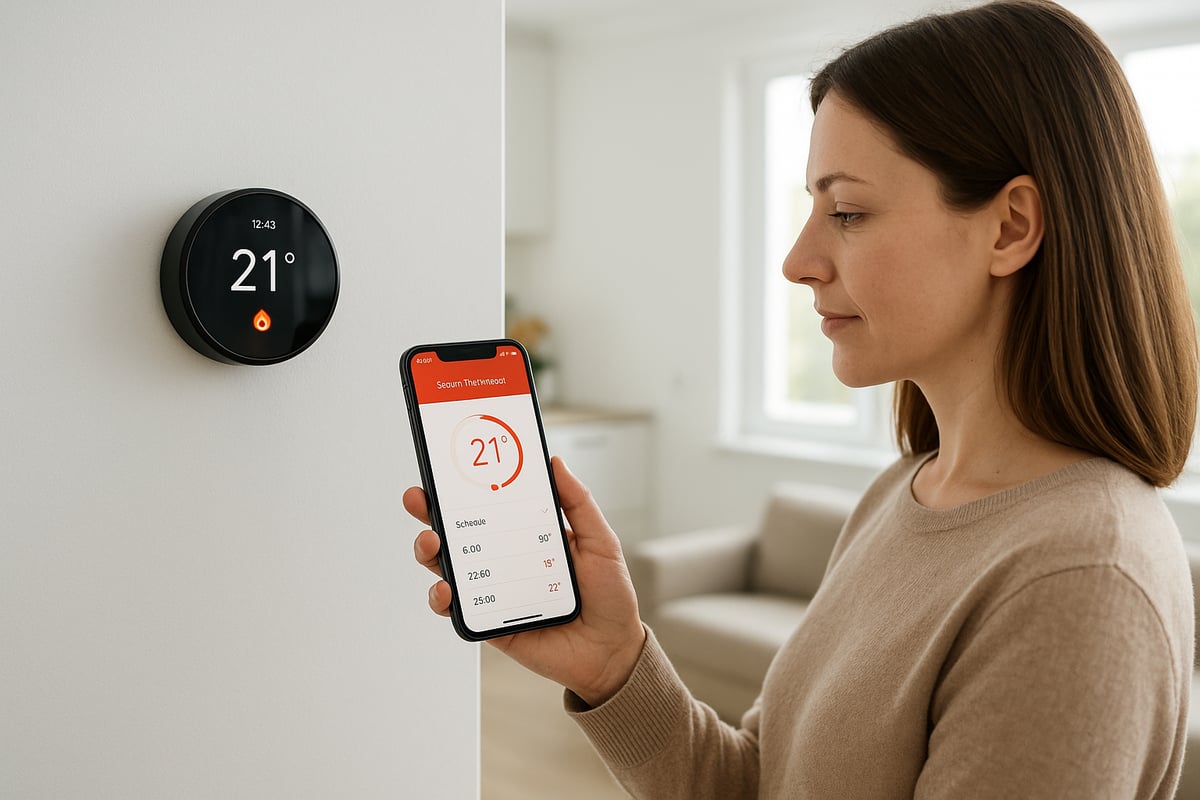Heating Controls Upgrade Guide: Your 2025 Step-by-Step Companion
Is your home ready for the smarter, more efficient heating demands of 2025? With energy costs rising and technology advancing rapidly, the need for an effective heating controls upgrade has never been greater. Modern systems offer not just comfort, but also compliance with new regulations and significant savings.
This guide provides a step-by-step approach to your heating controls upgrade, helping you make informed choices and maximise every benefit. You will discover what heating controls are, why upgrades matter, how to select and install the right system, and how to keep your investment future-proof.
Prepare to take control of your comfort, energy use, and compliance for the year ahead.
Understanding Modern Heating Controls
The world of heating controls has changed significantly in the past decade. Whether you are new to the topic or considering a heating controls upgrade, understanding how far these systems have come is essential to making the right choice for your home.

Evolution of Heating Controls
Heating controls have evolved from basic manual dials to today’s sophisticated smart systems. In the past, homeowners relied on analogue timers and simple thermostats with limited options. The 2010s brought digital programmable thermostats, allowing users to set schedules and fine-tune temperatures.
Smart technology has since transformed the landscape. App-based controls, wireless connectivity, and learning algorithms now offer unprecedented convenience. Analogue controls required manual input, while digital and smart options offer automation and remote access. If you want to understand the basics before your heating controls upgrade, you may find the Beginner's guide to smart heating controls helpful.
Types of Heating Controls Available in 2025
In 2025, a variety of heating controls are available to suit different needs. The most popular types include:
- Programmable thermostats for scheduled heating
- Smart thermostats with app and voice control
- Zoning systems for room-by-room management
- Thermostatic Radiator Valves (TRVs) for individual radiators
Many leading brands now offer advanced features such as geofencing, learning routines, and detailed energy reports. For instance, compare Hive, Nest, and Tado in the table below:
| Feature | Hive | Nest | Tado |
|---|---|---|---|
| App Control | Yes | Yes | Yes |
| Learning Algo | No | Yes | Yes |
| Geofencing | Yes | Yes | Yes |
| Zoning Support | Yes | Limited | Yes |
When planning your heating controls upgrade, consider which features will provide the most value for your household.
Benefits of Upgrading Heating Controls
A heating controls upgrade can deliver substantial benefits. Improved energy efficiency is a major advantage, with the Energy Saving Trust reporting up to a 30% reduction in energy use after upgrading. Enhanced comfort and customisation allow you to tailor your home environment to your needs.
Modern systems give you control through smartphones and even voice assistants. In one real-world example, a family reduced their annual heating bill by over £200 after installing a smart thermostat and TRVs. These savings, combined with increased comfort, make a heating controls upgrade a worthwhile investment.
Regulatory Changes and Compliance
From 2025, UK regulations require all domestic properties to meet stricter standards for heating controls. Boiler Plus legislation sets minimum requirements for energy efficiency and advanced control features. Non-compliance can result in penalties, but incentives are available for early adopters.
When planning a heating controls upgrade, staying compliant is crucial. Upgraded systems ensure you avoid fines and benefit from potential government grants. Always check that your chosen controls meet these new standards before installation.
Common Myths and Misconceptions
There are several myths around heating controls upgrade decisions. Common misconceptions include:
- “Smart controls are too complex to use.”
- “Upgrades are too expensive and not worth it.”
In reality, most modern systems are designed for easy setup and everyday use. Many brands offer step-by-step guides and customer support. While there is an upfront cost, the long-term savings and improved comfort often outweigh initial expenses. A heating controls upgrade is more accessible and beneficial than many homeowners expect.
Assessing Your Current Heating System
Understanding your starting point is crucial for a successful heating controls upgrade. Before diving into new tech, take time to evaluate what you have and what you need. This step ensures a smooth transition and maximises the benefits of your investment.

Identifying Existing Heating Controls
Start your heating controls upgrade by pinpointing your current setup. Look for the main thermostat, which may be located in your hallway, living room, or near the boiler. Older systems often feature simple analogue dials, while newer ones use digital displays or touchscreens.
Check for additional components like programmer units or individual radiator valves. These clues help distinguish between legacy manual systems and modern programmable or smart controls.
- Analogue: rotary dial, no digital screen.
- Digital: LCD display, programmable settings.
- Smart: Wi-Fi symbol, app compatibility.
Knowing your existing controls is the first step on your heating controls upgrade journey.
Evaluating Compatibility with New Controls
Not every system is ready for a heating controls upgrade. Begin with a checklist:
- Boiler type (combi, system, conventional)
- Wiring configuration (number of wires, terminals)
- Connectivity (Wi-Fi, Zigbee, Z-Wave)
Review your boiler’s manual for supported control types. Some older boilers may need adapters or additional wiring. If you’re unsure, consult a professional or use online resources like the Smart heating controls service to see which upgrades fit your system.
A careful compatibility check avoids wasted time and ensures your heating controls upgrade delivers the results you expect.
Signs You Need an Upgrade
Is your heating system showing its age? There are clear warning signs that a heating controls upgrade is due:
- Inconsistent room temperatures despite regular adjustments.
- Frequent system breakdowns or error messages.
- High energy bills with no obvious cause.
- Reliance on manual or analogue controls.
If you experience any of these, modernising your controls can improve reliability and comfort. A heating controls upgrade addresses inefficiencies and prepares your home for future demands.
Gathering Essential Information Before Upgrading
Before scheduling your heating controls upgrade, collect vital details:
- Model and serial numbers of your current thermostat and boiler.
- Installation dates and any previous upgrade records.
- User manuals, if available.
This information helps installers ensure compatibility and speeds up the installation process. Keeping these records also supports future warranty claims. By being organised, you’ll make your heating controls upgrade straightforward and stress-free.
Step-by-Step Heating Controls Upgrade Process
Upgrading your heating controls is a structured process that can transform your home's comfort, efficiency, and compliance. By following each step methodically, you ensure your heating controls upgrade delivers the best results, avoids pitfalls, and maximises your investment. Let's walk through the journey from setting your goals to mastering your new system.

Step 1: Setting Upgrade Goals
The first step in any heating controls upgrade is defining what you want to achieve. Are you aiming to cut energy bills, improve convenience, or enable remote access? Setting clear objectives helps you choose the right system and features.
For example, a family with unpredictable schedules may prioritise zoning controls, ensuring each room is heated only when needed. Others might focus on integrating with smart home systems or boosting overall comfort.
By clarifying your goals, you lay the foundation for a successful heating controls upgrade. This ensures every decision aligns with your household's unique needs and future plans.
Step 2: Researching Suitable Heating Controls
Once your objectives are set, research is crucial. Compare brands, features, and technologies to find the best fit for your heating controls upgrade. Consider the size of your home, existing boiler type, and compatibility with current systems.
Create a shortlist by:
- Reviewing user feedback and expert reviews
- Comparing smart and programmable options
- Assessing integration with your home network
A well-informed choice at this stage sets the tone for a smooth heating controls upgrade. Remember, not all systems offer the same benefits, so prioritise those that align with your goals.
Step 3: Budgeting and Planning
A successful heating controls upgrade requires careful budgeting and planning. Itemise all costs, including the device, professional installation, and any accessories. Factor in potential energy savings, which can help offset upfront expenses.
Check for grants or incentives available in 2025. Some local authorities or energy providers may offer financial support for heating controls upgrade projects that improve efficiency.
By planning your budget, you avoid surprises and ensure your investment is both affordable and sustainable. This step also helps you schedule the upgrade at a convenient time for your household.
Step 4: Choosing a Qualified Installer
Selecting a qualified installer is essential for a safe and compliant heating controls upgrade. Always verify that your engineer is Gas Safe registered and experienced with modern heating controls.
Ask potential installers:
- Have you worked with my boiler model before?
- Do you offer a warranty on installation?
- Can you provide references or case studies?
A reliable installer ensures your heating controls upgrade meets regulatory standards and operates efficiently. Professional installation also protects your warranty and gives peace of mind.
Step 5: Preparing Your Home
Before installation day, prepare your home to streamline the process. Clear space around your boiler, radiators, and control panels. Secure pets and ensure the installer can easily access wiring and devices.
For a smart thermostat upgrade, check WiFi coverage in the installation area. Gather all relevant documentation, such as manuals and previous service records.
Taking these steps supports a smooth heating controls upgrade. It minimises disruption and helps the installer complete the job efficiently and safely.
Step 6: Installation and Setup
During the installation phase, your chosen engineer will remove old controls, fit new devices, and connect them to your heating system. They will test the setup and guide you through initial programming.
Expect to:
- Download and configure any required apps
- Set your first heating schedules
- Test remote and manual control functions
A well-executed installation ensures your heating controls upgrade works seamlessly from day one. Early testing helps identify any issues and ensures full system functionality.
Step 7: Learning to Use New Controls
After installation, take time to learn your new system. Read manuals, explore app features, and set up routines that match your lifestyle. Many smart controls offer tutorials or customer support for troubleshooting.
To avoid common pitfalls, review advice on common mistakes with smart thermostats. This resource highlights issues users face after a heating controls upgrade and offers practical solutions.
Mastering your new controls ensures you enjoy all the benefits of your heating controls upgrade, from energy savings to improved comfort and convenience.
Choosing the Right Heating Controls for Your Home
Selecting the right system for your heating controls upgrade is crucial for achieving comfort, efficiency, and regulatory compliance in 2025. With so many options available, understanding the key aspects will help you make a confident, future-proof choice.

Key Features to Look For
When planning a heating controls upgrade, focus on features that deliver real value. Look for programmability, remote access via smartphone, and energy usage reporting. Multi-zone support allows different rooms to be heated independently, saving energy and boosting comfort.
Compare popular smart controls in a table:
| Feature | Hive | Nest | Tado |
|---|---|---|---|
| App Control | Yes | Yes | Yes |
| Learning Algorithms | No | Yes | Yes |
| Geofencing | Yes | Yes | Yes |
| Multi-zone Support | Yes | Limited | Yes |
For a deeper dive into the most important options, see this guide on the features of smart thermostats.
Smart vs. Programmable vs. Manual Controls
Choosing the right type of system is a critical part of a heating controls upgrade. Manual controls are basic, offering on and off functions with little flexibility. Programmable thermostats allow you to set schedules for different times of day, improving efficiency.
Smart controls take things further, providing app access, learning routines, and integration with voice assistants. For busy families or those seeking maximum savings, smart controls often offer the best balance between convenience and performance.
Manual options suit those who prefer simplicity or have limited connectivity. Programmable systems are ideal for predictable routines. Smart controls are best for tech-savvy users seeking full control and automation.
Compatibility with Existing Systems
A successful heating controls upgrade relies on your new controls working seamlessly with your current setup. Check your boiler type, wiring, and connectivity before purchasing.
Popular brands such as Hive and Drayton are known for broad compatibility with UK heating systems. Always confirm with manufacturer guidelines or consult a professional to avoid installation issues.
If you have an older system, upgrading may require additional components or wiring adjustments. The right compatibility ensures your investment delivers the expected benefits.
User Experience and Accessibility
An effective heating controls upgrade should be easy to use for everyone in your home. Look for intuitive interfaces, clear displays, and straightforward mobile apps.
For elderly or disabled users, features like voice control, large buttons, and accessible menus can make a big difference. Many smart thermostats now support integration with Alexa, Google Assistant, or Apple HomeKit, further enhancing accessibility.
Prioritise systems that offer strong customer support, easy-to-follow manuals, and helpful online resources. The right user experience ensures all household members can manage comfort independently.
Security and Data Privacy
Security is a top priority in any heating controls upgrade. Smart systems process personal data, so ensure your device uses encryption and secure authentication.
Major brands comply with GDPR requirements, protecting your privacy and data. Look for clear privacy policies and regular firmware updates to guard against vulnerabilities.
If security is a concern, choose brands with a strong track record and transparent data management practices. This gives peace of mind while enjoying the benefits of advanced heating controls.
Troubleshooting and Maintenance Post-Upgrade
Upgrading your heating controls can transform comfort and efficiency, but it is essential to know how to keep your system running smoothly. After a heating controls upgrade, you may encounter minor teething problems or require ongoing maintenance to maximise long-term benefits. Proactive care and timely troubleshooting ensure your investment remains future-proof and compliant.
Common Issues After Upgrading
Following a heating controls upgrade, some users face connectivity glitches or unexpected system behaviour. You might notice the app not syncing, schedules being ignored, or difficulty pairing devices.
Common issues include:
- Intermittent Wi-Fi connection resulting in lost remote access
- Incorrect time or temperature scheduling
- Integration problems with older boilers or other smart devices
Most problems are easily resolved by resetting devices or updating software. If you have just completed a heating controls upgrade, double-check your user manual for troubleshooting steps. Taking notes on specific error messages can also help when seeking support.
Routine Maintenance Tips
Regular maintenance after a heating controls upgrade is crucial for system reliability. Simple routines can prevent most issues and extend equipment lifespan.
Essential maintenance tasks:
- Check for software updates monthly to ensure security and performance
- Replace batteries in wireless thermostats and sensors as needed
- Gently clean thermostat screens and sensors to avoid dust build-up
Keeping a log of maintenance activities after your heating controls upgrade can help you spot recurring issues early. Remember to store manuals and installer contacts in an accessible location.
Maximising Efficiency and Savings
A heating controls upgrade is most effective when used strategically. Set up optimal schedules, adjust temperatures for different zones, and leverage smart features like geofencing to minimise wastage.
For example, using geofencing allows your system to adjust heating based on your location, reducing costs when the house is empty. According to Energy Savings with Smart Thermostats, ENERGY STAR certified smart thermostats can reduce heating and cooling costs by about 8 percent. This demonstrates the financial benefit of a heating controls upgrade when properly configured.
Experiment with settings and review energy reports to identify further savings opportunities.
When to Seek Professional Help
If you encounter persistent problems after a heating controls upgrade, such as frequent disconnections or unexplained heating faults, it may be time to call a professional.
Look for these signs:
- Installation errors or exposed wiring
- System not responding to any commands
- Repeated error codes or warnings
Contact your installer or the manufacturer's support team for advice. Keeping records from your heating controls upgrade, including installer details and warranty information, will streamline the process and ensure issues are resolved efficiently.
Future-Proofing Your Heating Controls Investment
Is your heating controls upgrade ready for the future? As technology evolves rapidly, making smart choices today ensures your system remains efficient, compliant, and sustainable for years to come. In this section, we will explore how to keep your investment adaptable and valuable.
Upcoming Trends in Heating Technology
The heating controls upgrade landscape is shifting towards smarter, interconnected solutions. Artificial intelligence is revolutionising controls, enabling systems to learn your habits and optimise energy use automatically. Integration with renewable sources, such as solar panels and heat pumps, is increasingly common, supporting low-carbon living and aligning with national goals.
The adoption of these trends is driven by both consumer demand and regulatory changes. For example, the Future Homes Standard Overview outlines requirements for low-carbon heating in new UK homes, pushing the market towards innovation. Staying aware of these trends ensures your heating controls upgrade will remain relevant as new technologies emerge.
Scalability and Modular Upgrades
When considering a heating controls upgrade, opt for systems designed with scalability in mind. Modular controls allow you to start with basic features and expand functionality as your needs change. For example, you might begin with a single-zone setup and later add multi-zone support or additional sensors for more precise control.
This approach protects your investment, as you can adapt to new technologies or lifestyle changes without a complete system overhaul. Look for brands that offer easy-to-install add-ons and support regular firmware updates. A flexible heating controls upgrade ensures your system remains effective as your home and requirements evolve.
Staying Compliant with Evolving Regulations
Regulations for heating controls are changing quickly in the UK. A heating controls upgrade must meet or exceed new standards to avoid penalties and maximise incentives. The 2025 regulations require advanced controls in domestic properties, making compliance not only a legal obligation but also a smart investment.
Keep up to date with the UK Heating Control Regulations 2025 to ensure your system remains compliant as rules evolve. Staying informed will help you avoid costly retrofits and ensure your heating controls upgrade delivers lasting peace of mind.
Environmental Impact and Sustainability
A thoughtful heating controls upgrade can significantly reduce your household's carbon footprint. Smart controls optimise energy use, reducing waste and supporting the transition to sustainable heating. According to research on the energy impacts of smart home technologies, advanced systems can cut heating energy consumption by up to 30%.
By choosing energy-efficient controls, you not only save money but also contribute to national and global climate goals. Your heating controls upgrade is a direct step towards a more sustainable, environmentally responsible home.
You’ve now seen just how much a heating controls upgrade can enhance your comfort, efficiency, and peace of mind as we head into 2025. Whether you’re motivated by energy savings, new regulations, or the desire for a smart home, having the right experts by your side makes all the difference. If you’re ready to take the next step or want advice tailored to your property in Kent, I recommend reaching out to the professionals who know your local area best.
Keeping Homes in and around kent Warm, Dry & Flowing Book with castle heating kent

